History of Warsaw

The history of
The city has had a particularly tumultuous history for a European city. It experienced numerous plagues, invasions, and devastating fires. The most destructive events include the Deluge, the Great Northern War (1702, 1704, 1705), War of the Polish Succession, Warsaw Uprising (1794), Battle of Praga and the Massacre of Praga inhabitants, November Uprising, January Uprising, World War I, Siege of Warsaw (1939) and aerial bombardment—and the Warsaw Ghetto Uprising, Warsaw Uprising (after which the German occupiers razed the city).
The city has hosted many crucial events in the history of Poland. It was the site of election of Polish kings, meeting of Polish parliament (Sejm), and events such as the Polish victory over the Bolsheviks at the Vistula, during the Battle of Warsaw (1920). In recent years the history-laden city has grown to become the multicultural capital of a modern European state and a major commercial and cultural centre of Central Europe.
Early history
The first fortified settlements on the site of today's Warsaw were
The first historical document attesting to the existence of a Warsaw castellan dates to 1313.
At that time, Warsaw housed about 4500 people. In the 15th century, the town spread beyond the northern town wall, and a settlement, New Town, began. The existing settlement became known as Old Town. Each had its own town charter and government. The aim of establishing a new town was to regulate the settling of new people who weren't allowed to settle in Old Town (mainly Jews)[4]
In 1515, during the Muscovy-Lithuanian War, fire (probably lit by Russian agents) burned a large part of Old Warsaw.[5] Gross social inequality and wealth disparity led in 1525 to the first revolt of the poor of Warsaw against the rich and their abuse of power.[3] This struggle resulted in the so-called third order being added to the city's authorities, sharing power with the two bodies controlled by the patrician class: the council and the assessors.[3] The story of Warsaw's struggle for social liberation dates from this time.[3]
Upon the extinction of the local ducal line, the duchy was reincorporated into the Polish Crown in 1526 (according to gossip, the last Mazovian prince, Janusz III, was poisoned on the orders of the Polish queen, Bona Sforza, and King Sigismund I).[1]
1526–1701
In 1529, Warsaw for the first time became the seat of the

However, by 1575 (when

Due to its central location between the
In the following years, the town expanded into the suburbs. Several private independent districts were established, the property of aristocrats and the gentry, which were ruled by their own laws. Such districts were called jurydyka. They were settled by craftsmen and tradesmen.
1700–1795

Warsaw jurydykas New Town |
A number of political circumstances ensured that after the death of King John III's, Poland–Lithuania entered into a period of decline relative to the other powers of Europe. A new king, the Saxon Prince-Elector Frederic Augustus was elected in 1697, who took the name
Augustus II died in February 1733. In September, the Polish gentry again elected as King Stanisław Leszczyński, but it did not matched the political interests of Austria and Russia, which, one month later, forced the Sejm to elect the Augustus II's son,
In 1740 Stanisław Konarski, a Catholic priest, founded Collegium Nobilium, a university for noblemen's sons, which is the predecessor of the University of Warsaw. In 1742, the City Committee was established, which was responsible for building of pavements and sewage system. But large parts of the greater Warsaw urban area remained out of control of the municipal authorities. Only in the 1760s did the entire Warsaw urban area come under one administration, thanks to efforts of the future President Jan Dekert (in Poland, the mayors of bigger cities are called Presidents). Before, the greater Warsaw urban area was divided into 7 districts.[4]

In 1764, a new Polish king was elected, the pro-Russian Stanisław August Poniatowski. Poland became practically a Russian protectorate after his election. In 1772, the first partition of Poland took place. Polish historians state that the partition was the necessary shock for the Polish gentry to “wake up” and start to think about the future of the country. Owing to the reforming mood, the Enlightenment excised massive influence in Poland and along with it, new ideas of the improvement of Poland. In 1765, the King established Korpus Kadetów, the first secular school in Warsaw. Despite its name, it was not a military school. In 1773, the first ministry of education in the world came into existence: the Commission of National Education (Komisja Edukacji Narodowej).[citation needed] In 1775, a new bridge on the Vistula was built, which lasted until 1794.
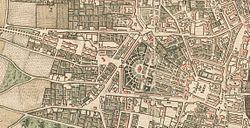
This time marked a new and characteristic stage in the development of Warsaw.[3] It turned into an early-capitalistic principal city. The growth of political activity, development of progressive ideas, political and economic changes – all this exercised an impact on the formation of the city whose architecture began to reflect the contemporary aspirations and trends.[3] Factories developed, the number of workers increased, the class of merchants, industrialists and financiers expanded.[3] At the same time there was a large-scale migration of peasants to Warsaw.[3] In 1792, Warsaw had 115,000 inhabitants as compared with 24,000 in 1754.[3] These changes brought about the development of the building trade. Noblemen put up new residences, and the middle class built houses that showed a marked social differentiation.[3] The residences of the representatives of the wealthiest stratum – the big merchants and bankers – matched those of the magnates.[3] A new type of city dwellings developed, catering to the needs and tastes of the bourgeoisie. The artistic medium for all these buildings was that of antiquity, which, although its different social origin was not analyzed at the time, expressed the progressive ideas of the Enlightenment.[3]
In 1788, the Sejm gathered to discuss the ways to improve the political situation and to regain the full independence. As Poland was more or less a de facto Russian protectorate, the

After the Battle of Maciejowice General Tadeusz Kościuszko was captured by the Russians. The internal struggle for power in Warsaw and the demoralisation of the city's population prevented General Józef Zajączek from finishing the fortifications surrounding the city both from the east and from the west. At the same time the Russians were making their way towards the city. The Russian forces reached the east outskirts of Warsaw on November 3, 1794. The heavy fighting lasted for four hours and resulted in a complete defeat of the Polish forces. Only a small part managed to evade encirclement and retreated to the other side of the river across a bridge; hundreds of soldiers and civilians fell from a bridge and drowned in the process. After the battle ended, the Russian troops, against the orders given by General Alexander Suvorov before the battle, started to loot and burn the entire borough of Warsaw (allegedly in revenge for the slaughter or capture of over half the Russian Garrison in Warsaw[15] during the Warsaw Uprising in April 1794, when about 2,000 Russian soldiers died[16]). Almost all of the area was pillaged, burnt to the ground and many inhabitants of the Praga district were murdered. The exact death toll of that day remains unknown, yet it is estimated up to 20,000 men, women and children were killed.[17] In Polish history and tradition, these events are called “slaughter of Praga”. A British envoy, William Gardiner, wrote to British Prime Minister William Pitt the Younger that “the attack on the Praga's lines of defense was accompanied by the most gruesome and totally unnecessary barbarousness”.[18]
After the fall of Kościuszko Uprising, The Polish–Lithuanian Commonwealth was finally divided between the three neighbors (the 3rd partition, 1795): Russia, Prussia and Austria. Warsaw found itself in the Prussian part and became the capital of South Prussia (Südpreußen).
Another result of the Great Sejm works directly concerned Warsaw: on 21 April 1791 it passed the City Act, which cancelled jurydykas. Since that time, Warsaw and its former jurydykas have constituted a homogeneous urban organism under one administration. As a memento of this event, April 21 is celebrated as the Warsaw Day.
1795–1914
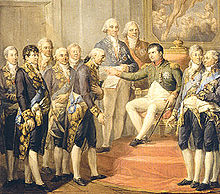
Warsaw remained the capital of the Polish–Lithuanian Commonwealth until 1795, when it was annexed by the
Following the repeated violations of the Polish constitution by the Russians (especially after the Alexander I's death, when the reactionary

Growth of railways turned Warsaw into an important railways hub, as lines were opened

Warsaw flourished in the late 19th century under Mayor Sokrates Starynkiewicz (1875–92), a Russian-born general appointed by Tsar Alexander III. Under Starynkiewicz Warsaw saw its first water and sewer systems designed and built by the English engineer William Lindley and his son, William Heerlein Lindley, as well as the expansion and modernization of horsecars, street lighting and gas works.[1] Starynkiewicz also founded the Bródno Cemetery (1884), still one of the biggest European cemeteries. As a remembrance of the President, one of the Warsovian squares bears the name of Starynkiewicz, even though he represented the Russian authorities.
Warsaw's development, however, was accompanied by an intensive assault on Polish national identity. Russian authorities closed Polish schools and built more and more Orthodox churches. These acts were strongly opposed. On 27 February 1861, Russian troops fired on a Warsaw crowd that was protesting Russian rule.[20][21] Five people were killed. On 22 January 1863 a new uprising broke out. The Underground Polish National Government resided in Warsaw during January Uprising in 1863–4.[21] However, this uprising was mainly in the character of guerilla, therefore Warsaw did not distinguish itself in it. But, as a penalty, President Kalikst Witkowski, the Russian general and predecessor of Sokrates Starynkiewicz, constantly imposed tributes on Warsaw. After Cossacks and police fired on demonstrators in January 1905 (Revolution in the Kingdom of Poland (1905–1907), after the St. Petersburg's “bloody Sunday”), strikes broke out throughout Poland. The Alfonse Pogrom, entailing violent attacks on brothels and street fighting, occurred in May 1905.
First
In 1904, the first power plant was built. The city installed electric street lamps and, in 1908, opened the first electric tram route. In 1914, a third bridge opened—Most Józefa Poniatowskiego.
World War I
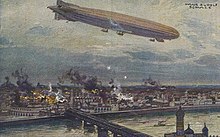
After nearly one year of fighting on the
The German authorities, headed by General Hans von Beseler, needed Polish support in the war against Russia, so they tried to appear friendly to the Poles. For example, they reintroduced the right to teach in Polish, and in 1915 they opened the Technical University, Warsaw School of Economics, and Warsaw University of Life Sciences.
However, the most important decision made for city development was to incorporate the suburbs. The Russian authorities hadn't allowed the extension the Warsaw's area, because it was forbidden to cross the double line of forts surrounding the city. For this reason, at the beginning of World War I on the area of today's Śródmieście and the old part of Praga (c. 33 square kilometres (13 sq mi) 750,000 people lived. In April 1916, the Warsaw territory extended to 115 square kilometres (44 sq mi).
In November 1918, the revolution broke out in Germany. On 8 November, German authorities left Warsaw. On 10 November Józef Piłsudski came to the Warsaw-Vienna Station. On 11 November the Regency Council gave him all military authority—and on 14 November, all civil authority. For this reason, 11 November 1918 is celebrated as the beginning of the Poland's independence. Warsaw became the capital of Poland.
1918–1939
The first years of independence were very difficult: war havoc, hyperinflation and the
On 16 December 1922, in the gallery

The other event was the
In 1925, there lived 1,000,000 people in Warsaw. In the next 5 years, the city's wealth doubled. It enabled to build new, broad streets as well as a new airport. The first airport, a temporary one, opened in 1921 in the park Pole Mokotowskie. The second, permanent, airport opened in Okęcie, where it remains. The city government worked out plans for a
In 1934, the
World War II
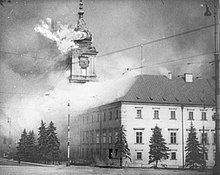
The first bombs fell on Warsaw already on 1 September 1939, the first day of the Nazi German invasion of Poland. The most important representatives of civil and military administration (along with the Army's Commander-in-Chief, Marshall Edward Rydz-Śmigły) escaped to the Kingdom of Romania, taking with themselves much of the equipment and ammunition intended for the defense of the city. To stop the chaos, Mayor Stefan Starzyński seized full civil power, although he had no entitlement to do this. To prevent public disorder, he appointed the Citizen Guard. All time he supported the people's spirit in radio speeches. On 9 September, the German Army tank divisions attacked Warsaw from south-west, but the defenders (with a lot of civil volunteers) managed to stop them in the Ochota district. The situation was hopeless. The Wehrmacht advanced so many divisions that sooner or later they would conquer the city, all the more so because on 17 September the Soviets invaded east Poland. Three days later the German encirclement around Warsaw closed. On 17 September, the Royal Castle burnt down, then, on 23, the power plant. On 27 September Warsaw surrendered and on 1 October the Germans entered the city. In September 1939, around 31,000 people died, (including 25,000 civilians) and 46,000 were injured (including 20,000 civilians). 10% of the buildings were destroyed.[8] On 27 October, the Germans arrested President Starzyński and deported him to the Dachau concentration camp, where he died in 1943 or 1944 (exact date still unknown).
During the

Since October 1940, the Germans had been deporting Warsaw's entire Jewish population (several hundred thousand, some 30% of the city) to the Warsaw Ghetto.[30] They amassed c. 500,000 people on the area of c. 2.6 square kilometres (1.0 sq mi). The occupying Germans caused the deaths of many through executions and hunger (the daily food ration for one Jew was only 183 kcal).[8] Since October 1941, every Jewish resident who had left the Ghetto as well as anyone who had been helping in any way the Ghetto residents (e.g. threw food over the Ghetto wall), had been punished with death.
When the order came to annihilate the Ghetto as part of Hitler's "Final Solution" on April 19, 1943, Jewish fighters launched the Warsaw Ghetto Uprising.[31] Despite being heavily outgunned and outnumbered, the Ghetto held out for almost a month.[31] When the fighting ended, almost all survivors were massacred, only few managed to escape or hide.[31][32] The commander of Verbrennungs und Vernichtungskommando ("Burning and Destruction Detachments"), Jürgen Stroop, destroyed the Ghetto so completely that even house walls did not remain.
By July 1944, the
The armed struggle, planned to last 48 hours, continued for 63 days, until 2 October. Eventually, the Home Army fighters and civilians assisting them were forced to capitulate.[33] They were transported to PoW camps in Germany, while the entire civilian population was expelled.[33]
The Nazis then essentially demolished Warsaw. Hitler, ignoring the agreed terms of the capitulation, ordered the entire city razed to the ground and the library and museum collections taken to Germany or burned.[33] Monuments and government buildings were blown up by special German troops known as Verbrennungs und Vernichtungskommando ("Burning and Destruction Detachments").[33] About 85% of the city was destroyed, including the historic Old Town and the Royal Castle.[34] In the uprising, c. 170,000 people died, of which only 16,000 were insurgents. The civilians (c. 650,000) were deported to the transit camp in Pruszków (Durchgangslager Pruszków).
On January 17, 1945, after the beginning of the
Modern times
In 1945, after the bombing, the revolts, the fighting, and the demolition had ended, most of Warsaw lay in ruins. Next to the remnants of Gothic architecture the ruins of splendid edifices from the time of Congress Poland and ferroconcrete relics of prewar building jutted out of the rubble.[3]
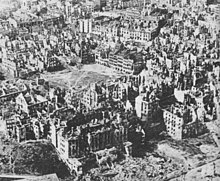
On 17 January 1945, the Soviet troops entered the left[clarification needed] part of Warsaw and on 1 February 1945 proclaimed the Polish People's Republic (de facto proclamation had taken place in Lublin, on 22 July 1944). At once, the Bureau of Capital's Rebuilding was established. The architects who worked for the Bureau, following the ideas of functionalism and supported by the Soviet puppet Communist regime, decided to renew Warsaw in modern style, with large free areas. They demolished many existing buildings and buildings that could have been rebuilt. Not all their ideas came off, however. In 1953, the Old Town and the Royal Route were reconstructed to look like they had before the war (aided by numerous pictures by many artists, including Canaletto). On the other hand, due to the absence of the "original" residents, the houses were settled by "common people"[who?] who often did not maintain the houses properly. The government did not undertake the complicated and expensive rebuilding of the Royal Castle.[citation needed] Almost all of the property was nationalized (see Bierut Decree).
Rebuilding the Old Town was an achievement on a global scale. In 1980, UNESCO appreciated the efforts and inscribed Old Town onto UNESCO's World Heritage list.[37]
The symbols of the new Warsaw were:
- Warsaw W-Z Route("Trasa W-Z") under the Old Town (1949)
- MDM estate (1952) (typical socialist realism architecture)
- Palace of Culture and Science(PKiN, 1955) a symbol of Soviet rule, and at that time the second tallest building in Europe
- 10th-Anniversary Stadium(1955).
Construction of the MDM estate and PKiN especially required demolishing existing buildings. Demolition, however, made it possible to create one of the street plans in Europe, aside from poor road conditions and badly planned crossroads.
In 1951, Warsaw was significantly enlarged again to address the housing shortage: from 118 square kilometres (46 sq mi) to 411 square kilometres (159 sq mi). In 1957, the town Rembertów was incorporated. On the incorporated areas, the city's government ordered the building of mainly large prefabricated housing projects, typical for Eastern Bloc cities.
The Soviet presence, symbolized by the Palace of Culture and Science, turned out to be very acute. Stalinism lasted in Poland until 1956—as in the USSR. The leader (First Secretary) of the Polish United Workers' Party, (PZPR), Bolesław Bierut, suddenly died in Moscow during the 20th Congress of CPSU in March, probably from a heart attack. By October, the new First Secretary, Władysław Gomułka, in a speech during a rally on the square in front of the PKiN supported the regime liberalization (so-called "thaw"). At first, Gomułka was very popular, because he also had been imprisoned in Stalinist prisons and as he had taken up the office of PZPR's leader, he promised a lot, but the popularity faded quickly. Gomułka was gradually tightening the regime. In January 1968, he forbade the performance of Dziady, a classical drama by Adam Mickiewicz, full of anti-Russian allusions. That was "the last drop of bitterness": then students went out on the Warsaw streets and gathered by the monument to Mickiewicz to protest against censorship. The demonstrations spread throughout the country, and the protestors were arrested by police. This time, the students were not supported by workers, but two years later, when in December 1970 the Polish People's Army fired at the protesting people in Gdańsk, Gdynia and Szczecin, those two social groups cooperated—and that helped end Gomułka.

Gomułka was succeeded by
In the crisis of the 1980s and hard time of martial law, John Paul II's visits to his native country in 1979 and 1983 brought support to the budding Solidarity movement and encouraged the growing anti-communist fervor there.[38] In 1979, less than a year after becoming pope, John Paul celebrated Mass in Victory Square in Warsaw and ended his sermon with a call to "renew the face" of Poland: Let Thy Spirit descend! Let Thy Spirit descend and renew the face of the land! This land![38] These words were very meaningful for the Polish citizens who understood them as the incentive for the democratic changes.[38]
From February to April 1989, the representatives of the Polish government and "Solidarity" were carried on the negotiations at the
After the political transformation, the Sejm passed an act, which reinstated the Warsaw city government (18 May 1990).
In 1995, the Warsaw Metro opened. It had been built since 1983.[39] In 2002, city Wesoła was incorporated into Warsaw[40] and capital of Poland expanded again by another 22.6 square kilometres (8.7 sq mi). In March 2021, plans were announced to add a third line to the city’s metro system, connecting the city centre with the district of Praga-Południe on the right (east) bank of the Vistula river, and later also with Ochota and Mokotów as a major part of a wider “New Opening” project that also included new pedestrian and cycling infrastructure in central parts of Warsaw.[41] On 28 September 2022, three new Warsaw metro stations were opened, increasing the number of Warsaw Metro stations to 36 and its length to 38,3 kilometers.[42] In February 2023, Warsaw’s mayor, Rafał Trzaskowski, announced plans to more than double the size of the city’s metro system by 2050.[43]
With the entry of Poland into the European Union in 2004, Warsaw experienced the biggest economic boom of its history.[44] Another important stimulator of the economy was the European football championship in Poland and Ukraine in 2012. Five matches, including the opening match, took place in Warsaw.[45] The city also hosted the 2013 United Nations Climate Change Conference[46] and the 2016 NATO Summit.[47]
As of August 2022, Warsaw had received around 180,000 refugees from Ukraine, because of the
Historical images
-
Ossoliński Palace and Kazanowski Palace in 1656
-
View of Warsaw from Praga in 1770
-
View of Warsaw from the Royal Castle in 1773
-
Marszałkowska Street in 1912
-
Modern architecture in Warsaw 1929
-
Warsaw 1935
-
Warsaw 1937
-
The National Museum in Warsaw 1938
-
Piłsudski Square in Warsaw 1939
-
Cavalry of Poland in Warsaw, August 1939
-
Warsaw 1939
-
Warsaw 1939 (Agfacolor)
-
Polish Army defending Warsaw 1939 (Kodachrome)
-
Warsaw after German bombardment in September 1939
-
American embassy in Warsaw during German air raid in 1939
-
Warsaw during German occupation in 1939
-
Warsaw Ghetto 1940-1943
-
Warsaw Ghetto Uprising in 1943
-
Warsaw Uprising in 1944
-
Warsaw Uprising in 1944
-
Warsaw Uprising in 1944
-
Warsaw, on the beach in the Fifties (YMCA HQ in the neighbourhood Saska Kępa).
See also
- Siege of Warsaw (1939)
- Siege (1940 film)
- Warsaw concentration camp
- Warsaw Ghetto Uprising
- Warsaw Uprising
- Warsaw Pact
- List of presidents of Warsaw
- Warsaw pogrom (1881)
- Timeline of Warsaw
References
- ^ a b c d e f g h i j "Warsaw's history". www.e-warsaw.pl. Retrieved 2008-07-24.
- ^ Paweł Giergoń. "Pomnik Stanisława Nałęcz hr. Małachowskiego". www.sztuka.net (in Polish). Archived from the original on 2012-02-10. Retrieved 2008-10-13.
- ^ ISBN 83-03-00702-5.
- ^ ISBN 0-19-925339-0.
- Warszawa1984, s. 34.
- ^ Neal Ascheron. "The Struggles for Poland". www.halat.pl. Retrieved 2008-07-24.
- ^ a b "Baltic campaigns: AD 1700–1706". History world. Retrieved 2008-08-27.
- ^ ISBN 83-89632-04-7.)
{{cite book}}: CS1 maint: location missing publisher (link - ^ a b "Royal Castle during the Saxons". Republika. Retrieved 2008-08-27.
- ^ "The Bygone Warsaw". Polbox. Archived from the original on 2008-03-14. Retrieved 2008-02-17.
- ^ a b Witt, Maria. "The Zaluski Collection in Warsaw". The Strange Life of One of the Greatest European Libraries of the Eighteenth Century. September 15 and October 15, 2005. FYI France. Retrieved 2008-02-17.
- ^ Chmielewski, Lech. "In the House under the Sign of the Kings". Welcome to Warsaw. Home. Archived from the original on 2009-02-03. Retrieved 2008-02-17.
- )
- ISBN 0-19-820171-0.
- ^ Madariaga: Catherine the Great: a Short History (Yale) p. 175.
- ^ "According to one Russian estimate 20,000 people had been killed in the space of a few hours" (Adam Zamoyski: The Last King of Poland, London, 1992 p. 429)
- ^ Rzez pragi (in Polish), Interia, archived from the original on 2011-07-16, retrieved 2010-10-06.
- ISBN 0-691-02947-4. Retrieved 2009-01-28.
- ^ (in French) Zbigniew Naliwajek « Romain Rolland et la littérature polonaise », Revue de littérature comparée 3/2003 (n°307), pp. 325–38.
- ^ a b O'Brien, Augustin P. (1864). Petersburg and Warsaw: Scenes Witnessed During a Residence in Poland and Russia in 1863–4. R. Bentley. Retrieved 2009-01-28.
- ^ Robert Blobaum, Feliks Dzierzynski and the SDKPIL a study of the origins of Polish Communism, page 57
- ISBN 978-1-4058-2471-2– via Archive Foundation.
- ^ "Poland, History » Poland in the 20th century » From the Treaty of Versailles to the Treaty of Riga". Britannica. Retrieved 2008-07-14.
- ^ Kowalski, Zdzisław G. "Documents of the Battle of Warsaw 1920". Memory of the World. Archived from the original on 2008-12-05. Retrieved 2008-07-14.
- ISBN 83-07-00069-6.
- ^ "Błotne kąpiele samorządu Warszawy". Robotnik (in Polish). 8 September 1934. p. 2.
- ^ ISBN 9780517701485.
- ^ "Battle for Warsaw". www.open2.net. Archived from the original on 2010-06-15. Retrieved 2009-05-06.
- ^ "Warsaw". United States Holocaust Memorial Museum. Retrieved 2008-07-29.
- ^ a b c "The Warsaw Ghetto Uprising". United States Holocaust Memorial Museum. Archived from the original on 2008-05-17. Retrieved 2008-07-29.
- ^ "The Warsaw Ghetto Uprising". www.aish.com. Archived from the original on 2008-06-23. Retrieved 2008-07-29.
- ^ a b c d e f "Warsaw Uprising of 1944". www.warsawuprising.com. Retrieved 2008-07-14.
- ^ "Warsaw Uprising of 1944". www.warsawuprising.com. Retrieved 2008-07-14.
- ISBN 83-03-00702-5.
- ^ Zespół Doradców Prezydenta miasta stołecznego Warszawy (A Team of Advisers of the President of the Capital City of Warsaw) (2004). "Straty wojenne Warszawy 1939-1945. Raport (Warsaw's war losses 1939-1945. Report)" (PDF). www.um.warszawa.pl (in Polish). Retrieved 2008-07-24.
- ^ "Historic Centre of Warsaw". Unesco. Retrieved 2008-07-24.
- ^ a b c "Pope in Warsaw". Destination Warsaw. Archived from the original on 2009-02-02. Retrieved 2009-02-05.
- ^ "Warsaw Metro". railway-technology.com.
- ^ "Research Experience Letter" (PDF). wne.uw.edu.pl.
- ^ Wilczek, Maria (15 March 2021). "Warsaw announces third metro line to link second-largest district to centre". Notes From Poland.
- ^ "Inforegio - 3 subsequent stations of Warsaw's Metro Line 2 up and running!". ec.europa.eu.
- ^ Tilles, Daniel (14 February 2023). "Warsaw unveils plans to more than double size of metro". Notes From Poland.
- ^ "Attracting foreign investments". The Warsaw Voice. Archived from the original on 2007-11-08. Retrieved 2008-07-24 – via Poland trade.
- ^ "The National Stadium in Warsaw". Poland2012. Retrieved 2008-07-24.
- ^ "WARSAW CLIMATE CHANGE CONFERENCE - NOVEMBER 2013". unfccc.int.
- ^ "NATO summit, Warsaw, Poland, 8-9 July 2016". consilium.europa.eu.
- ^ "'Time stopped': Ukrainians long to go home as war drags on". AP News. 22 August 2022.
Further reading
- Published in the 18th and 19th centuries
- OL 23349695M
- "Warsaw". Hand-book for Travellers in Russia, Poland, and Finland (2nd ed.). London: John Murray. 1868.
- Published in the 20th century
- Ruth Kedzie Wood (1912). "Warsaw". The Tourist's Russia. New York: Dodd, Mead and company. OCLC 526774.
- "Warsaw". Russia with Teheran, Port Arthur, and Peking. Leipzig: Karl Baedeker. 1914. OCLC 1328163.
External links
- Historical Museum of Warsaw
- History of Warsaw
- Warsaw 1935 - virtual reconstruction of pre-World War II Warsaw
- Architecture of pre-war Warsaw
- The Virtual Jewish History Tour, Warsaw
- Jews in Warsaw (from Encyclopaedia Judaica 1971)






















